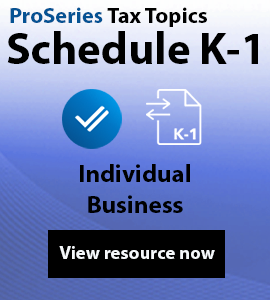- Topics
- Training
- Community
- Product Help
- Industry Discussions
- User Groups
- Discover
- Resources
- Intuit Accountants Community
- :
- ProSeries Tax
- :
- ProSeries Tax Discussions
- :
- Yes, if the brokerage statement contains the basis for ea...
Rather than enter many stock transactions from a brokerage statement, can the totals from the 1099-B Summary Section of the statement be entered ?
- Mark Topic as New
- Mark Topic as Read
- Float this Topic for Current User
- Bookmark
- Subscribe
- Printer Friendly Page
- Mark as New
- Bookmark
- Subscribe
- Permalink
- Report Inappropriate Content
Best Answer Click here
![]() This discussion has been locked.
No new contributions can be made. You may start a new discussion
here
This discussion has been locked.
No new contributions can be made. You may start a new discussion
here
Accepted Solutions
- Mark as New
- Bookmark
- Subscribe
- Permalink
- Report Inappropriate Content
Yes, if the brokerage statement contains the basis for each transaction and reports same to IRS.
Also yes if the brokerage does not report basis information to IRS and you attach the brokerage statement to the return.
- Mark as New
- Bookmark
- Subscribe
- Permalink
- Report Inappropriate Content
Yes, if the brokerage statement contains the basis for each transaction and reports same to IRS.
Also yes if the brokerage does not report basis information to IRS and you attach the brokerage statement to the return.
- Mark as New
- Bookmark
- Subscribe
- Permalink
- Report Inappropriate Content
Thank you for this. It's helpful.
Now, could someone tell me WHERE I enter summary data from a 1099-B with many transactions?
Is that on the "Capital Gain (Loss) Transaction Worksheet"?
Or Schedule D?
Is there a special worksheet for summaries?
Thank you!
- Mark as New
- Bookmark
- Subscribe
- Permalink
- Report Inappropriate Content
Someone may have a better technique, but this is how I make those entries:
AGGREGATED S/T SALES [BASIS RPTD, PDF ATTACHED], 12/31/19, VARIOUS, S
AGGREGATED S/T SALES [BASIS NOT RPTD, PDF ATTACHED], 12/31/19, VARIOUS, S
AGGREGATED L/T SALES [BASIS RPTD, PDF ATTACHED], 12/31/19, VARIOUS, L
AGGREGATED L/T SALES [BASIS NOT RPTD, PDF ATTACHED], 12/31/19, VARIOUS, L
I separate them like this because each category will generate a separate Form 8949.
I then strip the brokerage consolidated 1099 down to the 1099-B pages, type the client's name and SSN on the first page of the 1099-B, and attach it to the return for efiling.
- Mark as New
- Bookmark
- Subscribe
- Permalink
- Report Inappropriate Content
Thanks, Happy.




